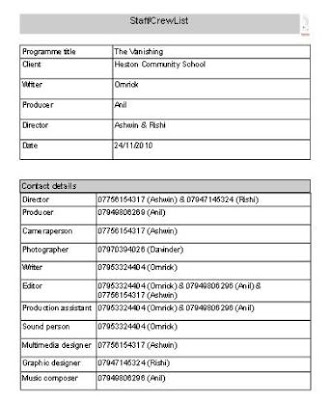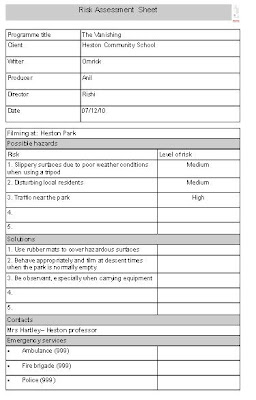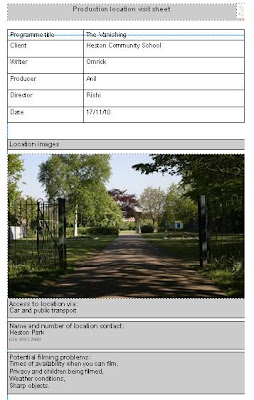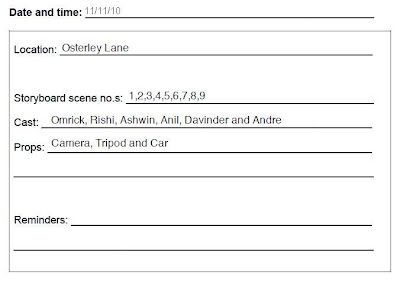Sunday, 12 December 2010
Final Trailer
Saturday, 11 December 2010
2nd Final Trailer Draft
Friday, 10 December 2010
Final Trailer Draft
Thursday, 9 December 2010
Final Trailer Title Design Draft
Wednesday, 8 December 2010
Final Trailer Print Screens


These three print screens were made from Final Cut Pro. The third print screen at the bottom shows an early stage in editing my final trailer. The timeline in this screen grab shows only the initial selection of shots prior to any audio being added. The timeline is illustrated as the horizontal pane in the lower third of the image and is a graphical representation of the edit.
The second print screen contains music, some sound effects and early title layers.
The last print screen shows the timeline containing the final edit. On closer inspection, several layers have been added to accommodate the production logo and intertitles. Also, by this stage the audio levels have been adjusted so the sound plays back correctly.
Tuesday, 7 December 2010
Final Production Logo

Monday, 6 December 2010
Personal Blog Entry
Sunday, 5 December 2010
Production Logo
Warner Brothers:

Universal:

Paramount:

Our production logo consists of a camera having an effect that ‘AROA productions’ is being emitted from it. This is deliberately done as we wanted to get a visual aid of the filming industry to be clear and direct, therefore containing a camera in our production logo. In further detail, the production logo is simple which has an advantage which gives the logo no specific genre attached to it. Thereby telling the audience that ‘AROA productions’ produce a variety of film and attracting a wide range of audiences.
However, I will create a new production logo that supports my trailer, reflecting the horror genre and creating a more required and specific production logo.
 When breaking down ‘AROA productions’, it is the initials of the first names of the group members. A- Anil, R-Rishi, O-Omrick and A for Ashwin. This created a visual aid and shows evidence of who made the film. On another level it also being the group together and enhances the groups moral.
When breaking down ‘AROA productions’, it is the initials of the first names of the group members. A- Anil, R-Rishi, O-Omrick and A for Ashwin. This created a visual aid and shows evidence of who made the film. On another level it also being the group together and enhances the groups moral.
Saturday, 4 December 2010
Intertitles
- Inspired by true events
- An AROA production
- Nominated for 3 nominations
- A Rishi Nahar film
- Coming Soon
Friday, 3 December 2010
Title Fonts
Font Titles on Prezi
Wednesday, 1 December 2010
Film Names

Monday, 22 November 2010
Mood Board
The photographs were taken by me as I supplied the 7.1 Olympus digital camera. Although the shots were taken in the dark, the flash did prove useful as it gave us a more of a distinct shot, creating a more enigmatic photo.
Overall, this mood board is a rough indication of what scenes that should be included when filming.
Mood Board on Prezi
Sunday, 21 November 2010
Props
Saturday, 20 November 2010
Production Schedule
Friday, 19 November 2010
Staff List

Thursday, 18 November 2010
Filming Schedule

Wednesday, 17 November 2010
Treatment

Tuesday, 16 November 2010
Risk Assessment
A risk assessment is a significant document as it reflects to a real life shooting of a film. From further research, when shooting a film, the crew, mainly the producer has to create a risk assessment outlining all the possible risks when filming, otherwise filming cannot commence.
Although this was ultimately a process of filling out the boxes, i felt this was a great learning curve. The reason for this is because when coming to actually shooting the film trailer, producing a risk assessment crates a more professional vibe and involves other group members for a more appealing experience.

Monday, 15 November 2010
Sunday, 14 November 2010
Daily Filming Sheet
Saturday, 13 November 2010
Shooting Script
Friday, 12 November 2010
Animatics
Thursday, 11 November 2010
Storyboards
The storyboard is essential to any 'film sketch and making'. Without it, processes, such as filming and editing will be extremely difficult and challenging. These rough sketches were drawn by the group and were equally distributed so that each member had contributed towards a scene and did not become a time consuming task.
However, this consisted of a minor set back, as the storyboard is not numbered in the consecutive order. This was a learning a curve of producing a storyboard and will not ignored, especially when filming and editing.
Ultimately, the storyboards consisted of the shot number, the visual aid, the dialogue, the camera movement and the length of that particular shot. These significant storyboards assured us roughly what order the film should take and helped structure the trailer and our time.







Wednesday, 10 November 2010
Character Analysis
Tuesday, 9 November 2010
Monday, 8 November 2010
Narrative Structure
The journey was a long and tiring one causing some characters to fall asleep in the vehicle. Suddenly they all jerked forward, along with seat belts tightening when the car arrived at a halt. The group all thought they had hit a deer, as it was a pitch black canvas in front. In fact, a puncture was the issue caused by a sharp object. All the characters were exhausted and peered over some bushes to find a forest in the distance to camp until morning. Bal who had a camera began to film his friends and the previous incident, having the urge to film everything. The group then decided to camp for the night but come across signs saying ‘no trespassing’. With four slightly drunken teenagers ignored the signs and climbed over the fence, inflicting a few bruises and scratches from the barbed wire on top of the fence.
As they began to set up camp Bal sees a strange figure amongst the trees through his camera. He tries to zoom in but is called by Ralph to help him set up his tent. He turns back around to focus in but seem to have a different perception of his initial visual scene. He tells the rest of the group what he thought he had seen but in an immature response, most of them ignored and laughed. After tents were all set up and positioned around the bushy area, they all began to gather firewood to build a fire. One of the boys brought a lighter and lit the twigs and bits of tissue to entice the fire. After a few minutes they all sat around the fire on logs and started to tell ghost stories. Little did they know knew, they were all in one.
The fire began to die out and made Ralph order Saif to collect some more fire wood. Saif gave a subtle sigh but arose above from where he had been sitting and walked into the darkness to gather the wo0d. Meanwhile the other three members, Ralph, Bal and Josh were just casually talking and saying how relieved they all were that they had finished their exams. Suddenly a loud scream came about and disturbed the tranquil atmosphere. The three of them went scampering into the bush, calling Saif to come out and stop horsing around. As time dragged on, those shouts turned into cries of ‘Saif, where are you?’ Along with Bal’s camera Ralph and Josh stood close but Bal suddenly fell and appeared to have stumbled on what was thought to be a log. It was Saif’s body left in a bloody mess. The group were shocked, stunned and devastated but above all they all panicked and ran straight back to the camp site. Only to find their tents and belongs to be tampered with and thrown around.
Josh then saw a tainted individual in the bush a few feet away from where he was standing. He approached in a weary and cautious manner and suddenly a huge axe split his head right down the middle. This quick bloody incident was observed Ralph, Bal and his camera. They both ran for the fence but in the drastic situation both students became separated from each other and were on their own in the pitch black darkness along with some strange hostile figure that was after them.
Ralph ended up running through a nearby cemetery. He came across a church which was found to be locked but was confronted with the killer which began the chase again. Footsteps changed to rapid speeds of pace from Ralph and the killer. The sound of the antagonist’s swinging bat became stronger and stronger, as opposed to Ralph’s speed. As Ralph was about to give up he saw that the killer was not behind him. He then turned, slowly. Crack and a series of bone crunching sounds arose from the killer’s bat.
The loud cries of agony were hear by Bal who was lost feeling petrified and looking for the fence shaking from the fear of death. Bal searched and searched and yet all seemed loss but the large fence was there in sight. Bal ran for it. The distance between the fence and him seemed an eternity but he made it to the silver barricade. He started to climb and accidently dropped the camera but half way he was grabbed by a hooded figure. Bal tried to fight him off. He was overpowered. Soon before Bal could even cry for help, a loud sickening thud echoed the forest, with the killer dragging the bat and the corpse behind him.
One week later the students were reported missing and one month later their corpses were found, lying next to each other with the colour of red bathed upon them. Inspectors and officials notified their senior staff and the student’s parents who were all sitting in a room. The police also discovered a video camera, which they all watched together.
Throughout the group, we all agreed on a strong narrative structure. Although we all have the same idea for the narrative structure, I manipulated mine to create a professional aspect in my media task linking to my trailer.
From analysing my narrative structure, there are several elements of where sound plays a vital role, such as when the killer is chasing and killing his victims. As a result I will make sure I will use sufficient sound in my trailer to add intensity towards the audience, enhancing the horror genre.
Sunday, 7 November 2010
The purpose of a trailer
Creating a film can be very expensive, with feature films need healthy takings at the box office to cover the costs of production, pay investors and make enough money for the next release. The film has a limited time to become a ‘box-office hit’. The marketing campaign is a significant element, as it informs the audience about the film with a purpose of attracting the people to watch the film. The companies who own the film and loan it to the cinema to show for short amount of time are called the distributors. If the film is a success it will make it easier for the distributors to construct a marketing campaign that aim to raise awareness of the film and increase interest. From this the distributors stand the best chance of making a profit on the film.
The trailer is a powerful ‘media platform’ in the marketing campaign. Posters are also important as they seek the initial interest of the audience but do not convey the excitement and tone of a film, in contras to a trailer. Combining the moving image and sound both experienced ‘larger than life’ through the advanced equipment of the cinema auditorium. The trailer is personified as it stirs our emotions and provides us with a ‘flavour’ of the film that is impossible through still images alone.
Trailer are created and produced simultaneously with the editing of the film. A very short version of the trailer, ‘teaser’ will be released early on in the marketing campaign to give people an idea of what the narrative of the film is. It is also constructed to give the audience a ‘buzz’ around release. ‘New technologies’, such as mobile phones, developing hardware and especially computers allow films to have their own websites t can be a form of communicating with the audience. From these websites, the film’s teaser trailer is often seen first online. After this, theatrical and television spots will begin to appear to maintain and strengthen the initial ‘buzz’.
When a film is being shown in a range of countries it is expressing the term of ‘global releasing’. The majority of the films we see in the UK originate from the US and the trailers have been created there, hence the use of American vocabulary and accent in the voiceover. Sometimes the trailer may be re-cut for different countries, with a different voiceover or even dubbed speech. In addition, there may be also alternative cuts of the trailer aimed at the interests of different audience groups.
‘Film piracy’ is a term that involves recording and copying a product, in this case a film. For example, a film in the USA is usually released before releasing in Europe. However, pirated versions of the film are released earlier than the original and actual film’s scheduled release date. As this can eat into box-office profits, those involved in promoting a film need to carefully control the process of release.
Along with the Internet Movie Database, Apple Movie Trailers and official websites for film titles often carry trailers that have been cut for general audience and so are suitable for viewers of any age. In contrast to the cinema, age restrictions can be very difficult to enforce. However, through blogging and social networking sites, from a film distributor’s perception, online marketing is a very effective technique to generate interest in the film before the film release.
Another element of film is its genre. Genre is significant in film marketing because our decision about what to see will partly depend upon whether we enjoyed other similar film. When we view a trailer we are automatically ‘decoding’ what we see and hear to establish the films genre. For instance, dark shadowy figures and scary music connotes a horror genre. Animated images and bright colours appeal to a simpler mind, thus attracting children.
Another indication as to the genre of a film is the stars. Different film actors and actresses link to specific genres, such as Jack Black heavily associates himself with comedy and Steven Seagal inking with action.
A trailer shows a film is worth going to see from its USP (unique selling point). This is what separates one film title from another released at a similar time or within the same genre. The USP could be the innovative use of special effects or it could be a star playing an ‘against role’. For example if an actor who normally plays a dominant hero in an action movie, he might play a weak and more emotional type of individual.
Trailers are not ‘mini-films’. They are a genre in there own right and are designed to capture our attention and hold it for a short space of time. One of the most significant aspects of this is the sound. Sound has a huge impact as it can manipulate our emotions and create a specific atmosphere. The voiceover, a feature of advertising, is used to summarise aspects of he story and emphasise credit information. The voiceover also looks to promote the film by building our anticipation.
Saturday, 6 November 2010
Friday, 5 November 2010
Personal Blog Entry
Tuesday, 2 November 2010
Inroduction
For my A2 Media Coursework i am going to construct a movie trailer, a poster and a magazine all relating the horror genre. In order for me to accomplish this construction of these significant media elements, I will first research horror trailers and films to acknowledge the key codes and conventions. However, I will also try and challenge the conventions, as this would come across as unique and fun. In further response to my research, I will also analyse horror trailers and look into the point and purpose of a trailer. As a result I will then begin to plan and create my own trailer within my group with the assistance of a story board.
Working in a group is also important, as this reflects the Media industry as it contains sectors in different Global institutions, such as Newscorp and Disney that require working in a team and co-operation to achieve a media platform, in this case a trailer.
Research and analysis is highly beneficial because it can help the group and I to understand the different types of a horror genre. For example, there can be forms of comedy horror (Shawn of the dead), romantic horror (Sleepy Hollow) or even psychological horror, which all have a variety of features that will have to assess before proceeding with the main the main task.
Also, to obtain a degree of creativity, I have also shot a photo from my digital camera of a individual person who's profile is not clearly shown. This is because I wanted to begin with the background having an immediate imapct of constructing an enigmatic feel. I have also added the design of the end of a role of film (the small squares on the outskirts of each photo). This is deliberatley done to portray a media film based style througout my blog, again linking to my main task.


























